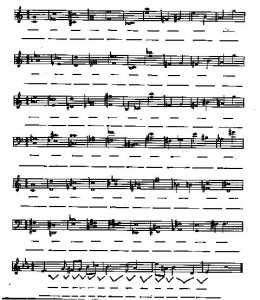Intervals
PDF of this page available
An interval is what we might call the distance between two notes. This distance is expressed as the number of steps of the scale between the lowest and the highest note, always counting the lowest as number one. For example C to G is a fifth, because we need 5 notes to go by alphabetic steps from C (through D,E & F) to G.
For the intervals below write ON THE TOP OF THE TWO ANSWER SPACES what distance apart the notes are. Use the following terms: 2nd, 3rd, 4th, 5th, 6th 7th, unison (if both notes are on the same line or space) and octave (if the notes are 8 steps apart and named with the same letter).
Qualifying the Intervals
You will have noticed that Eb – C as well as Eb – Cb or Eb – C# all count as intervals of the sixth. However, they cannot all be the same distance, because we know that Cb is deeper than C and that C# is higher than C. To be more accurate in naming the intervals we must qualify the distance, as measured numerically, with one of the following terms: Perfect, Major, Minor, Diminished or Augmented. This means that we should call Eb-C a major sixth; Eb-Cb a minor sixth; Eb-C# an augmented sixth. How we precisely arrive at these descriptions is given in the table below.
A: Always think of the bottom note as the first note of a major scale. If the top note in the interval fits to that major scale, then you describe the interval formed as a major 2nd, 3rd, 6th or 7th. Oddly, the other intervals in the major scale are not called major, but perfect. So get used also to the perfect unison, 4th, 5th and 8ve.
B: If the interval does not match up with the major or perfect intervals described in A above, but is a ‘narrower’ by one semitone, then you describe the interval formed as a minor 2nd, 3rd, 6th or 7th or a diminished unison, 4th, 5th or 8ve.
C: If the interval does not match up with the major or perfect intervals described in A above, but is a ‘narrower’ by two semitones, then you describe the interval formed as a diminished 2nd, 3rd, 6th or 7th or (in extremely rare cases) a double-diminished unison, 4th, 5th or 8ve.
D: If the interval does not match up with the major or perfect intervals described in A above, but is a ‘expanded’ by one semitone, then you describe the interval formed as an augmented 2nd, 3rd, 6th or 7th . Similarly you can also use the term augmented unison, 4th, 5th or 8ve.
Some examples:
- Thinking in Eb major, C is the sixth note. Therefore Eb-C must be a major sixth. (Model A above)
- However, Eb-Cb is a semitone ‘narrower’ than the interval Eb-C. So Eb-Cb must be a minor sixth. (Model B above)
- On the other hand, Eb-C# is a semitone greater than the interval Eb-C. So Eb-C# must be an augmented sixth. (Model D above)
Your exercise:
….is to return to your sheet called Intervals and on the lower of the two answer spaces write the appropriate qualifying term (major, perfect, minor, diminished or augmented) for each of the intervals you have named earlier.
Note:
- When two notes sound at the same time they are known as harmonic intervals.
- When an interval is formed by one note sounding after another, the interval is known as a melodic interval
To get a better feel for how the intervals sound follow this link

